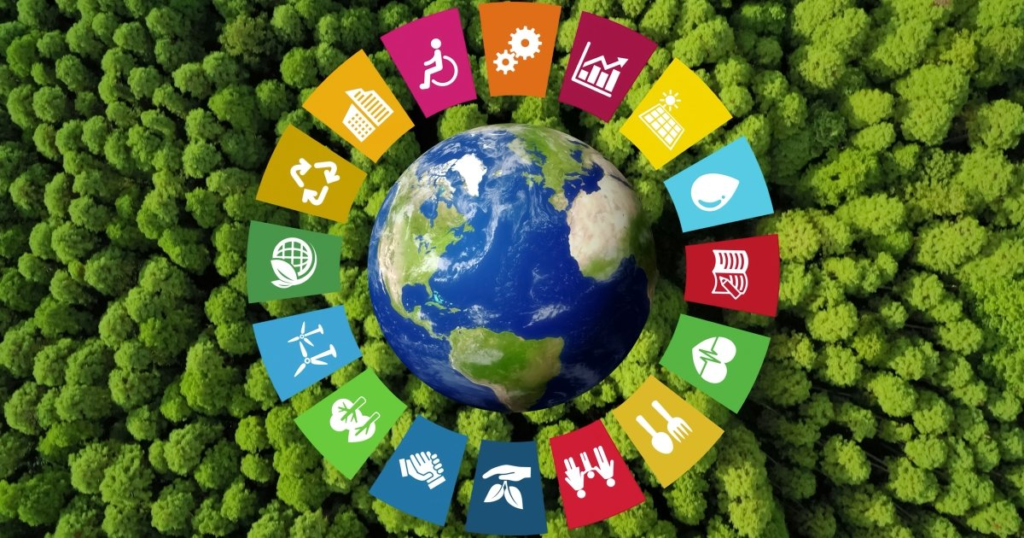Sustainable Future: Embracing Climate Resilience Trends to Address Environmental Challenges
Climate Resilience Trends : The world is at a critical juncture, facing an escalating threat that demands immediate action. Climate change, driven by human activities, poses a myriad of environmental challenges that must be addressed. This article embarks on a journey to explore the concept of climate resilience, a beacon of hope in our quest for a sustainable future. We will delve into why climate resilience is crucial, define its significance, and examine the pressing environmental challenges we face today.

Setting the Stage: Why Climate Resilience Matters
The stage is set, and it’s not a drama; it’s a global challenge. Climate resilience matters because our world is increasingly vulnerable to the unpredictable wrath of a changing climate. By embracing climate resilience, we equip ourselves with the tools needed to face the uncertainties and challenges of tomorrow.
Defining Climate Resilience and Its Significance
To understand its significance, we must first define what climate resilience means. It’s more than just surviving adverse conditions; it’s about thriving in the face of adversity. We’ll explore the multifaceted nature of climate resilience and why it’s pivotal in the fight against environmental challenges.
Understanding Environmental Challenges

To tackle climate resilience effectively, we must comprehend the environmental challenges that loom on the horizon. These challenges encompass a broad spectrum of issues, from melting ice caps to altered ecosystems. Identifying these challenges is the first step toward finding resilient solutions.
The Growing Threat of Climate Change
Climate change isn’t a distant future; it’s here, now. Rising global temperatures, extreme weather events, and the loss of biodiversity are all signs of a world grappling with the consequences of our actions. Understanding the gravity of these changes is vital to our journey toward climate resilience.
Identifying Key Environmental Challenges
From dwindling natural resources to the loss of habitats and the rise of pollution, our world faces a multitude of environmental challenges. We’ll delve into these challenges, exploring their far-reaching impacts and why they demand our immediate attention.
Climate Resilience: The Concept Unveiled
Now, let’s unveil the heart of our journey, the concept of climate resilience.
What Is Climate Resilience?
Climate resilience isn’t a single trait or a one-size-fits-all solution; it’s an intricate web of adaptability, sustainability, and foresight. We’ll dissect this concept, unraveling its components, and understanding why it’s an integral part of our sustainable future.
The Role of Adaptation in Climate Resilience
Adaptation is the dynamic force driving climate resilience. It’s about more than just surviving; it’s about evolving, learning, and growing. We’ll explore the central role of adaptation in climate resilience, emphasizing that flexibility is key to survival in a changing world.
Interconnectedness of Climate Resilience and Sustainability
Sustainability and climate resilience are inseparable twins in our quest for a better world. We’ll reveal the profound interconnections between these two concepts, demonstrating that building a resilient future requires a commitment to sustainability.
The Importance of a Sustainable Future

With the foundation laid, we’ll discuss why a sustainable future is not just an option but an ethical and practical imperative.
Embracing Sustainability for Ourselves and Future Generations
Sustainability is our gift to the generations yet to come. We’ll delve into why it’s not merely a noble gesture but a fundamental obligation we owe to the planet and our descendants.
Sustainability as the Key to Mitigating Environmental Challenges
Sustainability is not just a buzzword; it’s a practical toolkit for mitigating environmental challenges. We’ll explore how sustainable practices tackle the root causes of environmental problems and pave the way for climate resilience.
Stay tuned for the next part of our journey, where we’ll explore current trends in climate resilience efforts, the evolution of climate resilience practices, and the inspiring actions taken to put resilience into action.
Climate Resilience Trends: An Overview
In this section, we take a closer look at the dynamic landscape of climate resilience. It’s an ever-evolving field, and staying current with the trends is essential for making a meaningful impact.
Current Trends in Climate Resilience Efforts
Climate resilience is not static; it’s a field in constant motion. We’ll delve into the latest initiatives, innovative technologies, and adaptive strategies that are shaping the frontlines of climate resilience efforts.
The Evolution of Climate Resilience Practices
To understand the present, we must look to the past. The evolution of climate resilience practices provides us with valuable insights. By examining how we got to where we are today, we can better navigate the path toward a more resilient future.
Climate Resilience in Action
To fully grasp the significance of climate resilience, we must explore its practical applications.
Sustainable Infrastructure: Building for the Future
The built environment plays a pivotal role in climate resilience. We’ll investigate sustainable infrastructure practices, including green building technologies, resilient urban planning, and the innovative construction projects that are forging a path toward a more resilient future.
Ecosystem-Based Adaptation: Nature’s Resilience
Nature, with its intrinsic resilience, has much to teach us. Ecosystem-based adaptation leverages the resilience of natural systems to safeguard against environmental challenges. We’ll delve into the importance of wetlands, forests, and other ecosystems in climate resilience.
Community Resilience: Strengthening Local Ties

Communities are at the front lines of climate change. Strengthening community resilience goes beyond infrastructure; it involves empowering people and fostering local bonds. We’ll explore how communities worldwide are building their resilience in the face of change.
Technological Innovations in Climate Resilience
Technology has revolutionized nearly every aspect of our lives, and climate resilience is no exception.
Harnessing Technology for Resilient Solutions
From data-driven decision-making to cutting-edge technologies, we’ll uncover how innovation is shaping climate resilience. Smart solutions, such as renewable energy integration, real-time monitoring, and predictive analytics, are contributing to a more resilient world.
Smart Cities and Climate Adaptation
Cities are hubs of innovation and human activity, but they are also susceptible to climate change impacts. We’ll discuss the concept of smart cities and how data-driven urban planning, sustainable transportation, and advanced infrastructure are enhancing urban resilience.
Policy and Regulation: Driving Climate Resilience
Government policies and international agreements are key drivers of climate resilience.
Government Initiatives and Climate Resilience
National and local governments are increasingly taking proactive steps to bolster climate resilience. We’ll explore significant government initiatives and their impact on building a more resilient world.
International Agreements and Their Impact
Climate change knows no borders, and international agreements like the Paris Agreement have far-reaching implications. We’ll examine the importance of global cooperation and the role of such agreements in addressing environmental challenges.
The Role of Businesses and Corporations
The private sector is a significant player in climate resilience.
Corporate Sustainability Practices
Corporate responsibility extends beyond profit margins. We’ll discuss how businesses are adopting sustainable practices, reducing their environmental footprint, and incorporating sustainability into their core values.
Private Sector Initiatives in Climate Resilience
Some businesses are not just following the trend; they’re setting it. We’ll highlight innovative private sector initiatives that are driving change, from sustainable supply chains to circular economy practices.
In the next section, we’ll shift our focus to the individual’s role in building climate resilience, exploring the everyday actions that make a difference, the concept of personal resilience, and the power of educational outreach in spreading awareness.
Individual Contributions: Making a Difference
Amid the complex landscape of climate resilience, individual actions are pivotal. This section emphasizes the power of personal initiatives and the significance of personal resilience.
Everyday Actions for Climate Resilience
You don’t need to be a climate expert to make an impact. We’ll discuss practical, everyday actions that anyone can take to contribute to climate resilience. From conserving water to reducing waste and embracing sustainable transportation, these actions collectively create meaningful change.
Personal Resilience and Preparedness
Resilience isn’t just about adapting; it’s also about personal preparedness. We’ll explore the concept of personal resilience and how it empowers individuals to face environmental challenges with confidence. Whether it’s emergency preparedness or sustainable living, personal resilience contributes to the broader climate resilience effort.
Educational Outreach: Spreading Awareness
Education is a cornerstone in building climate resilience. Knowledge is a powerful tool, and it can drive positive change.
The Power of Climate Education
Climate education isn’t limited to classrooms; it’s a lifelong journey. We’ll discuss the significance of raising awareness about climate change, promoting climate literacy, and the transformative potential of education in inspiring action.
Engaging Communities in Climate Resilience
Communities are stronger when they work together. Community engagement is a vital component in building climate resilience.
Case Studies: Successful Climate Resilience Stories
Climate resilience isn’t just a concept; it’s a living reality that’s transforming communities and ecosystems around the world. These real-world success stories provide tangible evidence of what’s possible when we commit to addressing environmental challenges head-on.
In the coastal town of Wilmington, North Carolina, innovative adaptation strategies are protecting against rising sea levels and increasingly intense hurricanes. The construction of living shorelines and elevated homes showcases how nature-based solutions can enhance resilience while preserving the environment’s integrity.
Further north in New York City, the Big U project is an exemplar of urban resilience. This barrier system, which cleverly combines protection with community spaces, has fortified the city against future storm surges while providing recreational areas for residents.
Turning to international shores, the Netherlands’ Delta Works remains a testament to human engineering. This colossal system of dams, locks, and storm surge barriers stands as a shield against the encroaching sea, effectively protecting a nation largely below sea level.
In Australia, the Great Barrier Reef Marine Park Authority has been pioneering coral restoration techniques to combat bleaching. These efforts not only revive fragile ecosystems but also bolster the resilience of coastal communities reliant on the reef’s vitality.
These case studies illustrate that climate resilience is not a distant ideal but a practical, attainable goal. They are living proof that with innovation, collaboration, and unwavering determination, we can create a more resilient and sustainable world for current and future generations.
Highlighting Resilience Success Stories Worldwide
From small villages implementing sustainable farming practices to entire nations making groundbreaking policy changes, we’ll shed light on inspiring stories from around the world that exemplify the positive outcomes of climate resilience initiatives. These case studies serve as beacons of hope and a source of inspiration for those embarking on the path to resilience.
Overcoming Challenges in Implementing Climate Resilience
The journey to climate resilience isn’t without its obstacles. In this section, we explore the barriers that stand in the way and strategies to overcome them.
Barriers to Climate Resilience
In our pursuit of a more climate-resilient world, it’s imperative to recognize the multifaceted challenges that lie on the path to resilience. These challenges encompass a diverse array of obstacles that often test the limits of our determination. We’ll dive into these barriers, shedding light on the complexities that impede our progress.
Financial Constraints: Among the foremost barriers to climate resilience are the financial limitations that constrain our ability to enact change. Funding the necessary infrastructure, technologies, and adaptations can be a significant challenge, particularly for communities and regions already grappling with economic stress.
Political Hurdles: Politics, with its intricate web of policies and regulations, can either catalyze or hinder climate resilience efforts. Bureaucratic barriers, varying political priorities, and inconsistent environmental policies can slow down the implementation of resilience strategies.
Societal Reluctance to Change: Perhaps one of the most formidable challenges is societal reluctance to change. Overcoming ingrained habits and behaviors to embrace more sustainable practices can be met with resistance, skepticism, and the inertia of tradition.
Understanding and addressing these barriers is pivotal in our journey towards climate resilience. While challenges indeed exist, they are not insurmountable. Through innovation, collaboration, and a shared commitment to a greener future, we can collectively break down these barriers and pave the way for a more climate-resilient world.
Strategies to Overcome Obstacles
While challenges are present, solutions are abundant. We’ll delve into strategies and innovative approaches that can help us overcome the barriers and continue our journey toward a climate-resilient world.
Future Outlook: What Lies Ahead
As we journey toward a more resilient world, it’s essential to embrace the fact that building a sustainable future is an ongoing process. The path ahead is marked by challenges and opportunities, but our commitment to positive change remains unwavering.
The future outlook for climate resilience is multifaceted and intriguing. Anticipated developments on the horizon are poised to shape our path in remarkable ways. With innovative technologies and adaptive strategies, we’re poised to confront the ever-evolving challenges posed by a changing climate.
We view the future with a sense of optimism. Our world has witnessed the remarkable capacity for transformation and adaptation. We have seen communities, governments, and individuals come together to face environmental challenges head-on. These are the sparks of hope that will continue to ignite our progress.
But optimism must be balanced with realism. The road ahead is not without its obstacles, and there’s no silver bullet solution. Challenges, from financial constraints to political complexities, will persist. However, the collective determination to overcome these barriers is a testament to our resilience.
The journey toward a sustainable future is not a destination; it’s a perpetual commitment. Each step forward, no matter how small, contributes to a greener, more sustainable world. So, as we gaze into the future, let’s remember that the power for positive change lies in our hands, and the time for action is now.
Anticipated Climate Resilience Developments
What can we expect in the near and distant future regarding climate resilience? We’ll explore anticipated developments, from cutting-edge technologies to evolving policy landscapes, and consider how they will shape our journey.
The Ongoing Journey Towards a Sustainable Future
The path to a sustainable future is not linear; it’s a journey marked by continuous effort and commitment. As we conclude this article, it serves as a call to action, encouraging readers to embrace climate resilience and actively participate in the ongoing quest for a more sustainable, resilient, and vibrant world.
In our concluding section, we’ll summarize the key takeaways and emphasize the collective responsibility we share in building climate resilience for a better, greener, and more sustainable future.
Conclusion
In this comprehensive journey through the world of climate resilience and environmental sustainability, we have uncovered the intricacies of a subject that has never been more vital. The urgency to address environmental challenges is clear, and climate resilience stands as a beacon of hope. It’s more than a concept; it’s a way of life that empowers us to face an uncertain future with strength and adaptability.
We’ve delved into the significance of climate resilience and its interconnectedness with sustainability, emphasizing that this journey is not just about survival but thriving in the face of adversity. The pressing environmental challenges of our time, from climate change to habitat loss, are undeniable, but so is the human capacity to overcome them.
Our exploration has taken us through the evolving trends in climate resilience, demonstrating that adaptation is an ongoing process. Sustainable infrastructure, ecosystem-based adaptation, and community resilience have shown us the practical application of resilience concepts.
The role of technology, policy, and corporate responsibility has been highlighted, emphasizing that climate resilience is a collective effort that extends to governments, businesses, and individuals alike.
Individual contributions matter, whether through daily actions, personal resilience, or educational outreach. We’ve seen that spreading awareness and engaging communities are integral parts of the resilience journey.
In our discussions of case studies, we’ve witnessed success stories from around the world, proving that resilience is attainable. However, challenges persist, including financial constraints, political obstacles, and societal reluctance to change.
Yet, the future is filled with promise. Anticipated developments, from technological advancements to evolving policies, provide a glimpse of a brighter, more resilient tomorrow. The path to a sustainable future is ongoing, demanding continuous effort and commitment.
Embrace Climate Resilience for a Sustainable Future
As we conclude this extensive exploration, we are reminded that a sustainable future is not just a dream but a tangible goal. It’s a call to action for every individual, community, corporation, and government. By embracing climate resilience and actively participating in the journey toward a more sustainable and resilient world, we can address the pressing environmental challenges, foster a healthier planet, and create a brighter future for ourselves and generations to come.
Together, we can be the architects of a more resilient, sustainable, and harmonious world. The power is in our hands, and the time to act is now.
FAQ: Sustainable Future – Embracing Climate Resilience Trends to Address Environmental Challenges
What is climate resilience, and why is it important for a sustainable future?
Climate resilience refers to the capacity of a system or community to absorb and adapt to the impacts of climate change while maintaining its essential functions. It’s crucial for a sustainable future because it enables us to prepare for and mitigate the effects of environmental challenges, such as extreme weather events and rising sea levels, ensuring the long-term well-being of both nature and humanity.
What are the current trends in climate resilience efforts?
Current trends in climate resilience efforts include the development of sustainable infrastructure, ecosystem-based adaptation, and the utilization of technology to enhance resilience. Communities, governments, and businesses are also increasingly recognizing the importance of climate resilience and taking proactive measures.
How can I, as an individual, contribute to climate resilience?
You can make a difference by adopting sustainable practices in your daily life, such as reducing energy consumption, conserving water, and supporting local, environmentally friendly initiatives. Engaging in educational outreach and raising awareness about climate change is another valuable way to contribute.
What are the biggest barriers to climate resilience?
Barriers to climate resilience include financial constraints that limit investment in resilience projects, political obstacles that can hinder policy implementation, and societal reluctance to change, which can slow down the adoption of sustainable practices.
What can we expect in the future regarding climate resilience and environmental challenges?
The future holds promise, with anticipated developments in technology and policy that will shape our path toward a more resilient world. While challenges will persist, the collective commitment to overcoming these obstacles gives reason for optimism.
Why are case studies of successful climate resilience important?
Case studies provide real-world examples of how climate resilience efforts have been successfully implemented. They offer practical insights and inspire others to adopt similar strategies, showcasing that climate resilience is not just a theoretical concept but a practical and attainable goal.
How can businesses and corporations contribute to climate resilience?
Businesses can adopt corporate sustainability practices, reduce their environmental footprint, and invest in eco-friendly technologies. They can also participate in private sector initiatives that promote climate resilience and work towards sustainability goals.
What is the role of international agreements in climate resilience?
International agreements, such as the Paris Agreement, promote global cooperation in addressing environmental challenges. They set targets and standards for participating nations, encouraging them to adopt climate-resilient practices and reduce greenhouse gas emissions.
Explore our content.





